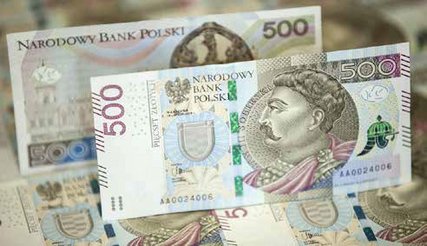

The Polish 500 Zloty – the Latest in the Rulers of Poland Series
At the High Security Printing Conference EMEA in Azerbaijan last month, Katarzyna Koczyk from the Cash & Issue Department of the National Bank of Poland presented the latest addition of the Polish banknote series: the new high value 500 zloty denomination (which was awarded the Best Regional Bankote of the Year ). Currency News™ takes a look at the new banknote and the reasons behind its issue.
Poland has seen continued economic growth since the 1990s and is today the eighth largest economy in the European Union in terms of GDP, according to the International Monetary Fund. The economic growth over the past 20 years has created a significant increase in the number of banknotes in circulation in the country, which the central bank estimates to be 120% between 2006 and 2016. With this increase in the number of notes, the value of cash in circulation (CIC) has also grown. CIC in Poland during the past six years has almost doubled, reaching 187 billion zloty (€43.5 million) in 2016. In February this year, the Bank identified that the 100 zloty denomination accounted for 63% of all banknotes in circulation, and when combined with the 200 zloty, accounted for 76%.
Rising economic growth leads to new note
In 1995, when the current Polish banknote series was first issued, the average Polish monthly salary was around 800 zloty. That figure has now increased to around 4,300 zloty (€1,000). These economic changes led the National Bank of Poland to re-examine their banknote structure and, using the D-metric® model, identified the need for a new high value denomination of 500 zloty (€118). The new note becomes the sixth denomination of the banknotes series, joining the 10, 20, 50, 100 and 200. The Bank intends that the note will ease demand for 100 and 200 zloty banknotes and will subsequently reduce banknote production costs. Though the current note series was upgraded in 2014, with the 200 zloty upgraded in 2016, the banknote family has been circulating for 22 years, suggesting that a new banknote series would have been the recommended course of action. But, says the Bank, with the possibility of joining the euro on the horizon, upgrading the notes of the current series with modern and up-to-date banknote security features was the recommended strategy. As such, the decision was made to extend the current banknote series with an additional high value denomination.

The 500 zloty was designed by Polish artist and banknote designer Andrzej Heidrich, who also designed the original banknote series. In line with the theme of the current series, namely ‘The Rulers of Poland’, the front of the new notes features a portrait of King John III Sobieski who ruled Poland from 1674 until 1696, with the design based on the coronation medallion made in 1676. The note’s reverse displays an image of the eagle in a crown (intaglio) and the Royal Palace in Wilanów – the summer residence of the time – in the background. The banknote includes Louisenthal’s Rolling Star® windowed security thread which changes colour from green to blue when the note is tilted. MultiCode®, Louisenthal’s machine readable magnetic feature, is incorporated within the thread. SICPA’s SPARK® Live Sandune optically variable ink feature is used to illustrate an image of a lobster-tailed pot helmet, worn by the 17th century Polish Hussars cavalry, shown on the front of the banknote. Like the thread, it is predominantly green in colour and, when the note is tilted, an ornamental line pattern can be seen shifting across the image.
As per the other denominations upgraded in 2014 and 2016, the 500 zloty banknote includes security features aimed at efficient machine readability. In addition to MultiCode, other magnetic properties have been added to the note and SICPA’s Level 2 infrared (IR) feature SICPATalk® is also included in the design.
Ultraviolet imagery (UV) is incorporated on both the front and back of the note displaying the note’s ‘500’ denomination value, the serial number and other graphic elements including the Wilanów Palace. The note also includes a covert Level 3 machine readable security feature.
Other security features include a multi-tonal electrotype watermark, a see-through register image, latent images, microlettering and the use of iridescent ink. Raised intaglio printing is incorporated in numerous places in the design, such as the diagonal lines positioned at the short edges of the note which are intended to assist those with visual impairments to identify the note’s denomination. The banknote’s dimensions are 150mm x 75mm, the largest of the family, following the trend of each denomination increasing slightly in size. The new 500 zloty is printed by Poland’s state printers, PWPW. Issued by the National Bank of Poland in February this year, 50 million notes were released into circulation.

Further Reading
RollingStar® Security Threads
RollingStar’s striking colour shift and dynamic effects are a real eye-catcher and ideal for immediate level-one authentication. Use them to achieve distinctive effects, such as the striking “rolling cube” where a truly dynamic colour shift reflection travels over the surface.